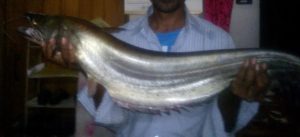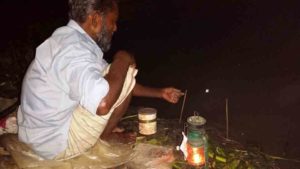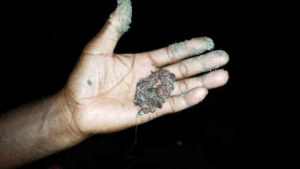
Photo courtesy: scotcat.com
If you visit Bangladesh anytime from July to November, and if you make a trip through any riverside village in the afternoon, then you surely will see lots of people sitting on the banks in a row, side by side. Their lanterns will soon be lightened up and it will seem like a chain of lights from a distance and you will obviously ask yourself what they are doing. Yes, they are fishing. Some of them are professionals, some are just hobbyists.
This is a very common scenario of a riverside village in rural Bangladesh from the late monsoon until the emergence of cold winter. They are the hunters of wallago attu, locally known as “Boal” fish. We have observed many of our foreign friends are tremendously interested in wallago attu. We get frequent queries from our visitors, asking lots of questions about this particular fish, for example- where they are found, how to catch them, what is the best bait, etc. Well, in this article we will try to unleash some of the mysteries of wallago attu AKA Boal fish.

Wallago attu is a freshwater fish, largely found in Bangladesh, India, Pakistan, Afghanistan, Burma, Vietnam, and Indonesia. It is a species of catfish and it comes from the family of Siluridae. It can grow up to 2.5 meters in length and weigh up to 60 kg (over 100 lbs). Wallago attu is also known as freshwater shark for its aggressiveness. It has no known enemy. It is armed with hundreds of razor-sharp teeth inside its jaws. This fish is an ultimate killer without any fear as well as a fast swimmer. Wallago attu goes for anything that goes around them. From small frogs to aquatic birds, from minnows to household pets, nothing goes unchallenged in front of this fish.

It is very common that you will find their stomach filled with different aquatic animals. Their are lots of local stories and myths about wallago attu and some of them are even as fascinating as the killing of human beings (I promise I am not trying to flatter Jeremy Wade). Even in a Bengali nursery rhyme, we can find ‘না নিয়ে গেলো বোয়াল মাছে, তাইনা দেখে ভোঁদড় নাচে’ meaning ‘the otter dances watching the wallago attu takes the boat’. I am not sure whether a boal of that size still exists or not which can take a boat but this particular fish has always been a part of Bengali culture and delicacy.
Wallago attu or Boal fish can be found all over in Bangladesh. It is a deep-water fish, that generally resides in large water bodies. During monsoon, they migrate upstream to shallower water for spawning. And during this time fishermen catch them on a greater scale. Sometimes these fish fall prey with full of eggs inside. Government should take extensive initiatives for creating awareness among the fishermen and locals not to catch fish during the spawning season. Besides, they should be given alternative ways of earning for their families during this time of year when there is no job for the village farming people as farmlands are still under monsoon water. Angling for wallago attu starts from late July up to Winter.

In Bangladesh people generally use a single hook directly connected to the main line without any lead. For baits, you have a wide range of choices. But rotten minnows are the mostly used. Earthworms are the best-known bait for wallago attu. This is a bottom feeder fish, so hook must reach the ground under the water. Bangladeshis generally fish in the evening for wallago attu as it is a nocturnal predator. It comes closer to banks in search of food and catches rats, insects, small fish, small snakes etc. So, we start with casting deeper, and as night falls late we cast relatively shallower water.

There are lots of places you can go for hunting wallago attu. All big rivers have plenty of this fish. The Padma (the Bangladeshi part of the Ganges), the Jamuna (a tributary of the old Brahmaputra river), and the Surma river of Sylhet are the best destination for extreme anglers. You can go to Aricha Ghat in Manikgonj district and set your lines in the Padma river for wallago attu. There are lots of beels, haors(large water bodies), and canals where you can go for this particular fish. Try to have some local knowledge before setting your lines. This really helps a lot. If you are after wallago attu, you must have an untold amount of patience.
This is a very sensitive fish. It doesn’t have very good eye sight but it has super sensitive lateral lines and a sharp hearing device that can detect the slightest vibration in water and can hear even the sounds that we can not hear. Use a sharp hook for wallago attu, because its inner mouth is very rough and do not drag instantly if your bait is taken. Because it runs a distance taking its prey in its mouth before finally swallowing it. And most people do the mistake at this point. They strike back and the fish leaves the bait. So, have a little patience and let it take the bait first. Count up to five then slowly tighten the line. You will have a great fight if you hook one. If you go to the bigger rivers for hunting wallago attu you should have enough line in your spool. 40lbs braided line is suggested in this case. And for small rivers, 20lbs braid or mono-filament will do just fine. Anyways, practice makes perfect and this fish will give you a really great experience.
By: Nasim Hasan














8 thoughts on “Wallago Attu (Boal Fish): A Dreamcatch to Every Bangladeshi Angler”
Dear Mr. Rezaul, thanks for your comment. By the way, until now anglinginbangladesh.com is a one man show. The concept behind A.I.B. was to build a strong community to ensure the flow of information regarding the game of angling in all around Bangladesh. We hoped that visitors would participate actively sharing their knowledge, know-hows, locations and with other technical stuffs about angling in this country. But it is sad that we have had no such visitors yet. But we are not hopeless at all. Everyone asks for recipes and formulas about hook baits, ground baits etc. But no one intend to share their knowledge with others which is very pathetic.
somehow I found this site which match my hobby. thanks for that. though there are various article in it but not updated. I’m planning to boal fishing, If you can provide me some help about appropriate bait for boal fishing i’ll be pleased. I will be waiting for any update.
For Boal fishing live baits are considered the best. Boal has a very strong smelling sensor. So anything with a very strong smell is very effective for boals. Earthworms and chicken liver paste are proven to be very productive.
Any readymade scent which used for boal fishing? if used available in bangladesh? pls.
There is no readymade scent or flavor for boals. Local knowledge is used widely for boal fishing which is being carried from generation to generation. And local knowledges have so far been proved as the best.
Soon we will publish hook baits and ground baits recipes from world class anglers of this Sub-continent which will cover everything about Rohu, Catla, Mrigal and other commonly targeted species of this region. Keep an eye on our page. Thanks. but we do not see your post about the hook baits & ground baits. since August 2, 2012 at 3:37 pm almost daily visit your post for that but did not see still.
how to prepare the minnows ? is it mix with bread and keep to rotten?
any do you have any suggestion for Katla fish bait. pls tell.
i am very new in angling
Thank you
Thanks for your query Tanvir. Boal is a predatory fish and they have a very weak eye sight. So It is best o use fresh live baits with a critically balanced rid for wallago attu. A helicopter rig is quiet preferable. Live earthworms are the best proven baits for them. You also can go for half rotten minnows as well. In that case make sure that your bait reaches the bottom.
For catla baits you can visit http://www.anglinginbangladesh.com/few-secrets-about-catla-baits/. Soon we will publish hook baits and ground baits recipes from world class anglers of this Sub-continent which will cover everything about Rohu, Catla, Mrigal and other commonly targeted species of this region. Keep an eye on our page. Thanks.